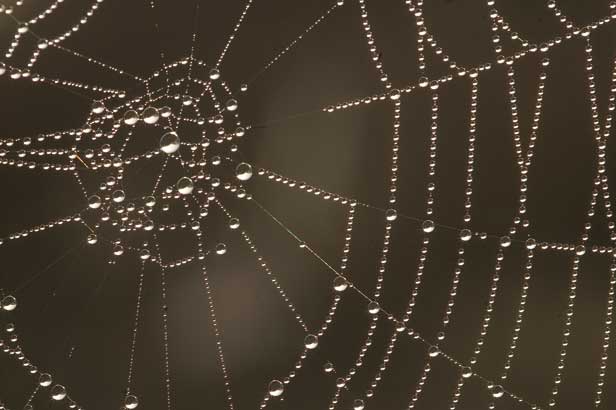
The silk that spiders use to build their webs, trap their prey, and dangle from the ceiling is one of the strongest materials known. But it turns out it’s not just the material’s exceptional strength that makes spiderwebs so resilient.
Markus Buehler, an associate professor of civil and environmental engineering, previously analyzed the complex structure of spider silk, which gains strength from different kinds of molecular interactions at different scales. In a cover story this February in Nature, he now says a key property of the material that helps make webs robust is the way it can soften at first when pulled, then stiffen again as the force increases. Its tendency to soften under stress was previously considered a weakness.
Buehler and his team, including graduate students Steven Cranford and Anna Tarakanova, analyzed how materials with different properties, arranged in the same web pattern, respond to localized stresses. They found that materials with simpler responses—they behave as a linear spring when pulled, or start out stretchy and then become more plastic—perform much less effectively.
Damage to spiderwebs tends to be localized, affecting just a few threads—the place where a bug got caught and flailed around, for example. This localized damage can simply be repaired, or just left alone if the web continues to function adequately. “Even if it has a lot of defects, the web actually still functions mechanically virtually the same way,” Buehler says.
To test the findings, he and his team literally went into the field, poking and pulling at spiderwebs. In all cases, damage was limited to the immediate area they disturbed.
This suggests that there could be important advantages to materials whose responses are complex and nonlinear. The principle of permitting localized damage so that an overall structure can survive, Buehler says, could end up guiding structural engineers. For example, earthquake-resistant buildings might flex up to a point, but if the shaking continued or intensified, specific structural elements could break first to contain the damage.
That principle might also be used in the design of networked systems: a computer experiencing a virus attack could shut down instantly, before its problems propagate. So the World Wide Web may someday grow more resilient thanks to lessons learned from the spidery construction that inspired its name.
Keep Reading
Most Popular
Large language models can do jaw-dropping things. But nobody knows exactly why.
And that's a problem. Figuring it out is one of the biggest scientific puzzles of our time and a crucial step towards controlling more powerful future models.
The problem with plug-in hybrids? Their drivers.
Plug-in hybrids are often sold as a transition to EVs, but new data from Europe shows we’re still underestimating the emissions they produce.
Google DeepMind’s new generative model makes Super Mario–like games from scratch
Genie learns how to control games by watching hours and hours of video. It could help train next-gen robots too.
How scientists traced a mysterious covid case back to six toilets
When wastewater surveillance turns into a hunt for a single infected individual, the ethics get tricky.
Stay connected
Get the latest updates from
MIT Technology Review
Discover special offers, top stories, upcoming events, and more.